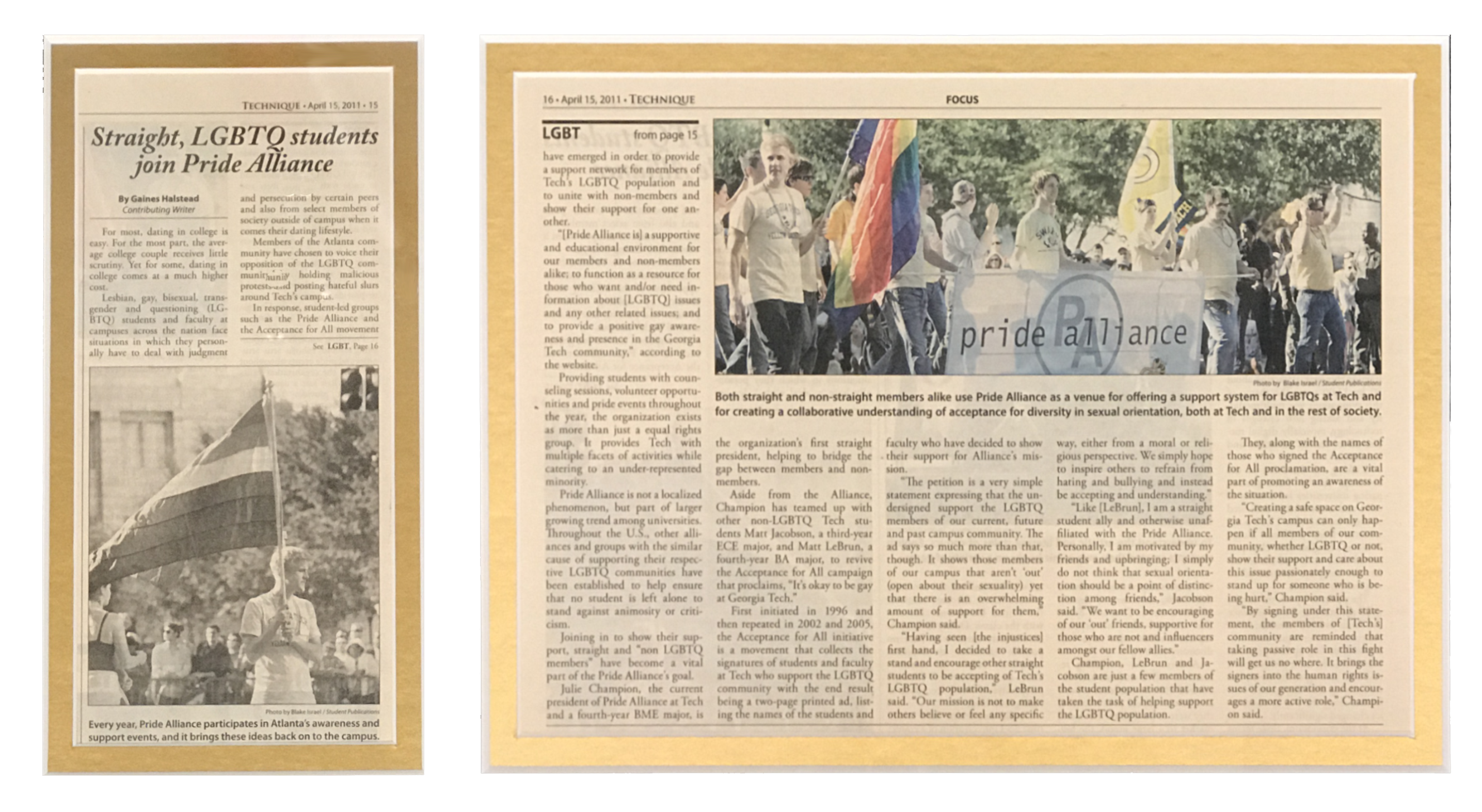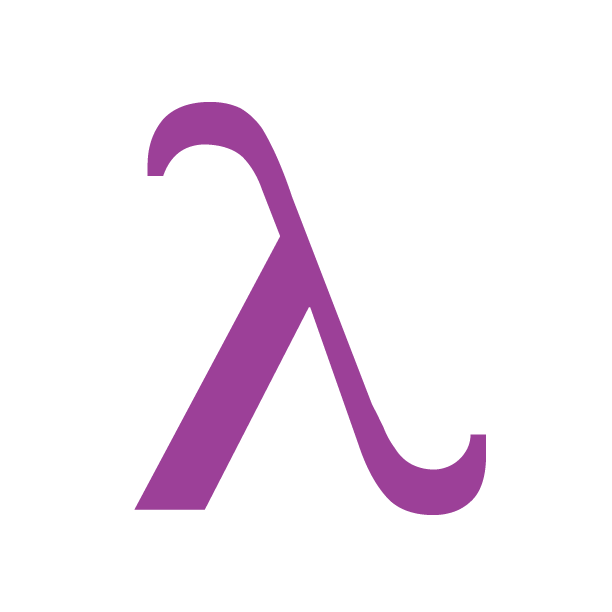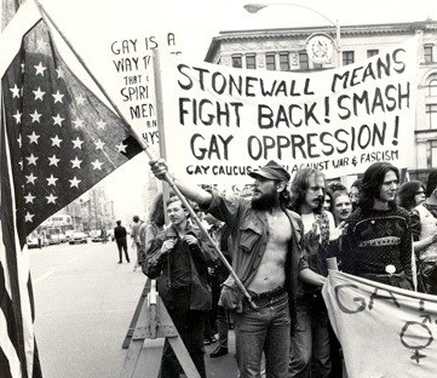Our History
The roots of Georgia Tech’s Pride Alliance go as far back as 1977. This first iteration of Georgia Tech’s LGBTQIA student organization was called Georgia Tech Gay Academic Alliance and sought to start the conversation about gay students on campus. This group was officially chartered in 1978; however, the charter was revoked in 1983 due to inactivity.
The next iteration of an LGBTQIA student group was the Gay and Lesbian Alliance. Amidst homophobia, social intolerance, and a conservative 1988 campus, an SGA debate was vehemently argued for the charter of a certain organization that year, and it was passed by a single vote. The Gay and Lesbian Alliance, as it came to be known, was established and it began to work for the betterment of Georgia Tech’s gay and lesbian students. The organization slowly built up its dedicated members to create its enduring legacy, and GALA continued for many years as a support group for Tech students. As time passed, however, the organization found itself trying to increasingly accomplish more, and its members took on the challenge of bringing GALA to new frontiers.
The current iteration of the LGBTQIA student organization started around 2002 with Pride Alliance, and its mission was now to serve the LGBTQIA and Ally community of Georgia Tech, rather than just gay and lesbian students. In 2003, Pride Alliance worked in collaboration with Dean Stephanie Ray and the Department of Housing to begin the Safe Space program at Georgia Tech. This program ran into some issues in 2006 when the school was sued over the content of the program.

The organization was fundamental to the establishment of the LGBTQIA Resource Center was established in 2014. This was a monumental leap for the community and for Pride Alliance itself. With the center came the opportunity for Pride Alliance to explore new areas of growth as the organization is no longer the only source of support for the community on campus. The LGBTQIA Resource Center works at an administrative level with many campus resources to ensure these resources are up to par to support our students.
The LGBTQIA students have always had to work hard to support their members and sometimes it still isn’t enough. In 2017 Pride Alliance president Scout Schultz was shot by campus police which jettisoned the Georgia Tech community into the spotlight. They were an excellent student and inspiring activist and their legacy lived on through the events that happened after their death. If you want to know what happened, this article gives a decent review of the events. Out of these events came the creation of the Action Teams which two Pride Alliance officers served. These teams created a long list of recommendations in November 2017 many of which are still being worked on today.
Pride Alliance continues the traditions of activism, volunteering, and providing safe spaces to its members. The organization strives for growth and has recently worked for specific LGBTQIA non-discrimination policy, gender inclusive housing and restroom policies, white papers, and social events for both members and outsiders. Pride Alliance is committed to serving the LGBTQIA people of Georgia Tech.
Lambda
The Encyclopedia of Homosexuality has the following entry on LAMBDA:

“In the early 1970's in the wake of the Stonewall Rebellion, New York City's Gay Activist Alliance selected the Greek letter lambda, which member Tom Doerr suggested from its scientific use to designate Kinetic Potential, as its emblem. (Curiously, in some ancient Greek graffiti the capital lambda appeared with the meaning "fellate", representing the first letter of either "lambazein" or "laikazein.") Because of its militant associations, the lambda symbol has spread throughout the world. It sometime appears in the form of an amulet hung round the neck as a subtle sign of recognition which can "pass" among unknowing heterosexuals as a mere ornament. Such emblems may reflect a tendency among homosexuals toward "tribalization" as a distinct segment of society, one conceived as a quasi-ethnic group.
In More Man Than You'll Ever Be by Joseph P. Goodwin (Indiana University Press:Bloomington, 1989) on page 26, Goodwin writes:
The lowercase Greek letter lambda carries several meanings. First of all, it represents scales, and thus balance. The Greeks considered balance to be the constant adjustment necessary to keep opposing forces from overcoming each other. The hook at the bottom of the right leg of the lambda represents the action required to reach and maintain a balance. To the Spartans, the lambda meant unity. They felt that society should never infringe on anyone's individuality and freedom. The Romans adopted the letter to represent "the light of knowledge shed into the darkness of ignorance." Finally, in physics the symbol designates an energy change.
Thus the lambda, with all its meanings, is an especially apt symbol for the gay liberation movement, which energetically seeks a balance in society and which strives through enlightenment to secure equal rights for homosexual people.
Stonewall Rebellion
It’s not easy to pinpoint one event as the beginning of a social movement, but many LGBTQIA people recognize the Stonewall Rebellion (June 28, 1969) as the single most important event leading to the fight for LGBT rights in the United States.

The events of the Stonewall Rebellion have been remembered, by many communities, in the month of June since the year 1970. Pride is celebrated in June to honor the courage of those who resist and rebel in the face of oppression. Some members of the LGBT community lamented the use of violence, and the today there are nonviolent marches, demonstrations, and peaceful protests to push forward equal rights, same-sex marriage, spouse and children laws, adoption, and legislation to protect LGBTQIA people. The LGBTQIA community honors those who demonstrated at the Stonewall Rebellion, which was the beginning of Pride.
Rainbow Flag
Gilbert Baker, a San Francisco artist, designed the first Rainbow flag in 1978, in response to a local activist's call for a community symbol. He designed a flag with eight stripes: pink, red, orange, yellow, green, blue, indigo and violet. According to Baker, those colors represented sexuality, life, healing, sun, nature, art, harmony and spirit. The artist personally dyed and sewed the first flag, in the spirit of Betsy Ross, and was soon approached by San Francisco's Paramount Flag Company, who wanted to produce and market his "gay flag". Unfortunately, Baker had hand-dyed all the colors and because hot pink dye wasn’t commercially available, mass production of his eight-stripe version was impossible. so the flag was reduced to seven strips.
